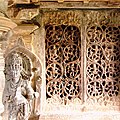Balligavi
| Balligavi | ||
|---|---|---|
|
|
||
| State : |
|
|
| State : | Karnataka | |
| District : | Shimoga | |
| Sub-district : | Shikarpur | |
| Location : | 14 ° 24 ' N , 75 ° 14' E | |
| Height : | 660 m | |
| Area : | 8.73 km² | |
| Residents : | 3,920 (2011) | |
| Population density : | 449 inhabitants / km² | |
| Balligavi - Kedareshvara Temple | ||
Balligavi or Belagavi ( Kannada ಬಳ್ಳಿಗಾವಿ ) is a village with just under 4,000 inhabitants (2011 census) in the Shimoga district of the Indian state of Karnataka . The place was an important sub-center of the Kadamba - or the Chalukya - and the Hoysala empire in the 4th and 5th as well as from the 10th to 12th centuries .
location
Balligavi is located in the transition zone between the rainy mountain range of the Western Ghats and the much drier Deccan Plateau to the east , at an altitude of around 660 m, about 3 km (driving distance) southeast of Banavasi , the former capital of the Kadamba Empire. The climate is tropical and warm; Rain (approx. 1065 mm / year) falls almost exclusively during the monsoon months from June to October.
Residents
The inhabitants of the place are almost without exception Hindus ; other religions are of minor importance in the rural regions of southern India. The male population is around 5% higher than the female population.
economy
Coconut palms and mango trees thrive in the region . In addition, grain and vegetables are grown , mainly for self-sufficiency . Cattle breeding (sheep, goats, chickens) is of little importance.
history
In the 4th / 5th In the 19th century, the area and the neighboring town of Talagunda, only about 4 km to the northeast, belonged to the Kadamba Empire. The place is first mentioned under its older names Baligrama , Dakshina Kedara , Valliggame or Valligrame in an inscription from the year 685 from Badami . There were six monasteries (mathas) and numerous other pilgrimage sites here; a higher educational institution is also said to have existed here. With the decline of the Early Chalukya Empire , the importance of Balligavi declined until it revived towards the end of the 10th century.
Attractions
- The - apart from three towers - flat-roofed Kedareshwara Temple is dedicated to the Hindu god Shiva and was probably built in the early 12th century. An inscription from 1131 mentions additions ( vyalas ) of the Hoysala dynasty, which has since followed the Chalukya . It consists of a flat-roofed vestibule ( mandapa ) with a large figure of a reclining Nandi bull, accessible via three entrance stairs and supported on the inside by channeled columns . This is followed by three clover-shaped and tower-crowned cellae ( garbhagrihas ), of which the two outer ones are dedicated to the Hindu gods Brahma and Vishnu ; In the middle cella is a lingam . The towers are structured both horizontally and vertically, although the figure decorations are limited to a few kirtimukha reliefs, and end in amalaka rings with kalasha jugs on top.
- In the adjacent museum several inscription steles from different times are kept, including a sati stone.
- The Tripurantakesvara Temple is dated around 1070. Several small erotic scenes can be found on the poorly structured exterior of the temple. The interior of the temple is noteworthy with numerous turned columns that support a rather crude ceiling. There are also finely crafted jali lattice cabinets and several expressive sculptures of gods and guardians that may have been added at a later date.
Entrance hall ( mandapa ) of the Tripurantakesvara temple
View from the dark cella ( garbhagriha ) onto the pillars of the bright vestibule
Lovers ( mithunas ) at the temple exterior
Web links
- Balligavi, Kedareshwara Temple - Photos and brief information (English)
- Balligavi, Kedareshwara Temple - Info (English)







